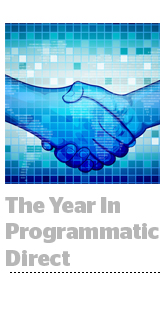 Although programmatic direct solutions – which automate direct relationships between sellers and buyers – started cropping up around six years ago, growth has been slow.
Although programmatic direct solutions – which automate direct relationships between sellers and buyers – started cropping up around six years ago, growth has been slow.
But that’s likely to change. eMarketer predicts automated direct deals will grow from $800 million this year to more than $8 billion in 2017, which would make programmatic direct 42% of the programmatic market.
These figures are up for debate. BuySellAds CEO Todd Garland estimates his company will bring in $14 million in revenue this year. As such, eMarketer’s estimate seems high to him.
But he agrees the space is growing quickly, as do others.
“2014 was the year automated guaranteed transformed from the technology everyone accepted as ‘one day inevitable’ to an opportunity actively pursued by early adopters,” said Adslot CEO Ian Lowe.
Carl Kalapesi, VP of industry initiatives at the IAB, predicts that in 2015 publishers will take fuller advantage of all programmatic solutions, “from automation of the direct deal through to preferred deals and private marketplaces all the way to the open auction.”
Programmatic direct solutions providers must scale their offerings and become part of an end-to-end solution that includes things like trafficking and billing in order to realize its full potential, Lowe said. Vendors kickstarted this process in 2014, through acquisitions and product developments.
“I expect to see a lot more consolidation as public markets provide capital for acquisitions and scale becomes the major driver of winning budgets,” agreed Mike Seiman, CEO and founder of ad holding company CPXi. “Companies need massive scale to be able to provide a full solution.”
Here are some of the highlights from this year in programmatic direct:
- January: Xaxis COO Mark Grether estimates during an eMarketer interview that 70% of all programmatic ad spending in Europe was programmatic direct. He said the figure is likely smaller in the US, though he was unable to specify.
- February: iSocket raises $5 million, bringing its total funding to $16.3 million. iSocket provides APIs that enable trading desks to manage programmatic direct inventory alongside RTB inventory.
- February: Google builds private exchanges for Time Inc. and the Local Media Consortium, a collective of 42 local media companies. As part of this deal, Google will direct deals between the publishers and buyers.
- April: Yieldex, largely seen as a provider of yield management tools, enters the programmatic direct space with YieldexDirect. By December, CEO Andy Nibley said 30% of Yieldex’s publisher clients had signed on.
- April: Facebook, prior to formally launching its revamped Atlas ad server, begins laying groundwork claiming Atlas would support programmatic direct buys, beginning with Microsoft inventory.
- April: Kantar Media SRDS partners with numerous SSPs (PubMatic, Rubicon Project, OpenX) and programmatic direct platforms (iSocket, Adslot, BuySellAds, Shiny Ads).
- July: Yieldex forms a partnership with reporting and discrepancy tool Ad-Juster, bringing automated guaranteed and billing closer together.
- September: Ad network Undertone releases its programmatic platform Virtuoso, which has a programmatic direct offering called ImpactDirect.
- October: PubMatic alludes to its entry into the programmatic direct space at its Ad Revenue conference; an end-to-end solution will be rolled out in spring 2015.
- October: Hearst Corp. enters a programmatic direct deal with Varick Media Management. The goal was to build Hearst’s premium business and use data so advertisers could target Hearst’s audience.
- October: Microsoft says it is in the process of developing programmatic direct tools to automate the workflow involved in selling directly.
- November: Rubicon Project buys iSocket and Shiny Ads for a combined $30 million, adding their technology and customers to Rubicon’s existing orders business.
- November: AdSlot ties its programmatic direct product into workflow automation via a partnership with Operative.
- December: BuySellAds contemplates funding following its assumptions that Google will enter the space in a few months as well as Rubicon’s acquisition of iSocket and Shiny Ads.













